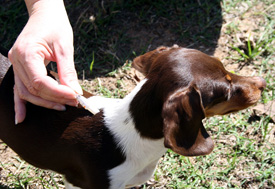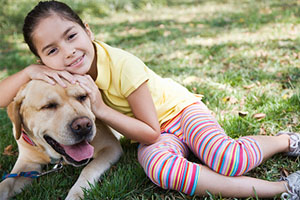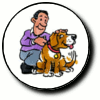Are spot-on flea and tick products safe for my pets?
1.800.858.7378npic@oregonstate.edu
We're open from 8:00AM to 12:00PM Pacific Time, Mon-Fri
A to Z
Are spot-on flea and tick products safe for my pets?

Spot-on flea and tick products are made as liquids. These are squeezed onto a dog or cat's skin, mostly between the shoulder blades or down the back. Adverse events associated with spot-on products are rare, but any flea and tick control product has some risks and can be hazardous, especially if used incorrectly. It is very important to read the package label and apply the product as directed, and at the time intervals listed on the label. This will lower any potential risks to your health and the health of your pets.
Tips for using spot-on flea and tick products
Before treating
- Read the label, even if you've used the product many times before, because the directions or warnings may have changed. If you don't understand the label, ask your veterinarian or call the manufacturer for clarification.
- When treating cats, be sure that the product is specifically labeled for use on cats. Never treat a cat with a spot-on product labeled for use on dogs.
- Be careful to match the product weight range to the weight of your pet. You must accurately weigh your pet and use only the product listing your pet's weight on its label.
- Don't try splitting a larger-size dose package to treat several smaller pets. It is impossible to provide an accurate dose and you could injure one or more of your pets.
- Do not apply a product to kittens or puppies unless the label specifically allows this treatment.

- Talk to your veterinarian before using a product on weak, old, medicated, sick, pregnant, or nursing pets, or on pets that have previously shown signs of sensitivity to flea or tick products.
After treating
- Keep multiple pets separated until the product dries to prevent one animal from grooming another and ingesting the pesticide.
- Monitor your pet for side effects after applying the product, particularly when using the product on your pet for the first time.
- Call your veterinarian if your pet shows symptoms of illness after using a product. Symptoms of poisoning include poor appetite, depression, vomiting, diarrhea, or excessive salivation.
- If your pet experiences a bad reaction from a spot-on product, immediately bathe the pet with mild soap, rinse with large amounts of water, and call your veterinarian.
Other considerations
- Use an Integrated Pest Management (IPM) approach including regular vacuuming to remove food, larvae and eggs, washing fabrics and bedding in hot water, and targeted treatments with insecticides containing insect growth regulators.
- Use flea combs to pick-up fleas, flea eggs, and ticks on puppies and kittens that are too young for flea and tick products.
- Use protective gloves when applying and wash your hands immediately with soap and water after applying a product.
- Store flea and tick products away from food and out of children's and pet's reach.
- Keep in mind that some pest control products for animals are considered drugs (pharmaceuticals). These are prescribed by veterinarians and regulated by the Food and Drug Administration (FDA).

If you suspect your pet has eaten any pesticide, you may call the National Animal Poison Control Center for medical treatment assistance at 1-888-426-4435 (a consultation fee may apply, which can be charged to a credit card). You may also contact your local veterinarian. Timely treatment could save your pet's life.

If you have questions about this, or any pesticide-related topic, please call NPIC at 1-800-858-7378 (8:00am - 12:00pm PST), or email us at npic@ace.orst.edu.
Are spot-on flea and tick products safe for my pets?
 |
Precautions for Using Spot-on Flea and Tick Products Episode 16 - A veterinarian gives pet owners some important pointers about using flea and tick spot-on treatments. Download and Listen, View Transcript - 2:38 min., 4.95MB |
